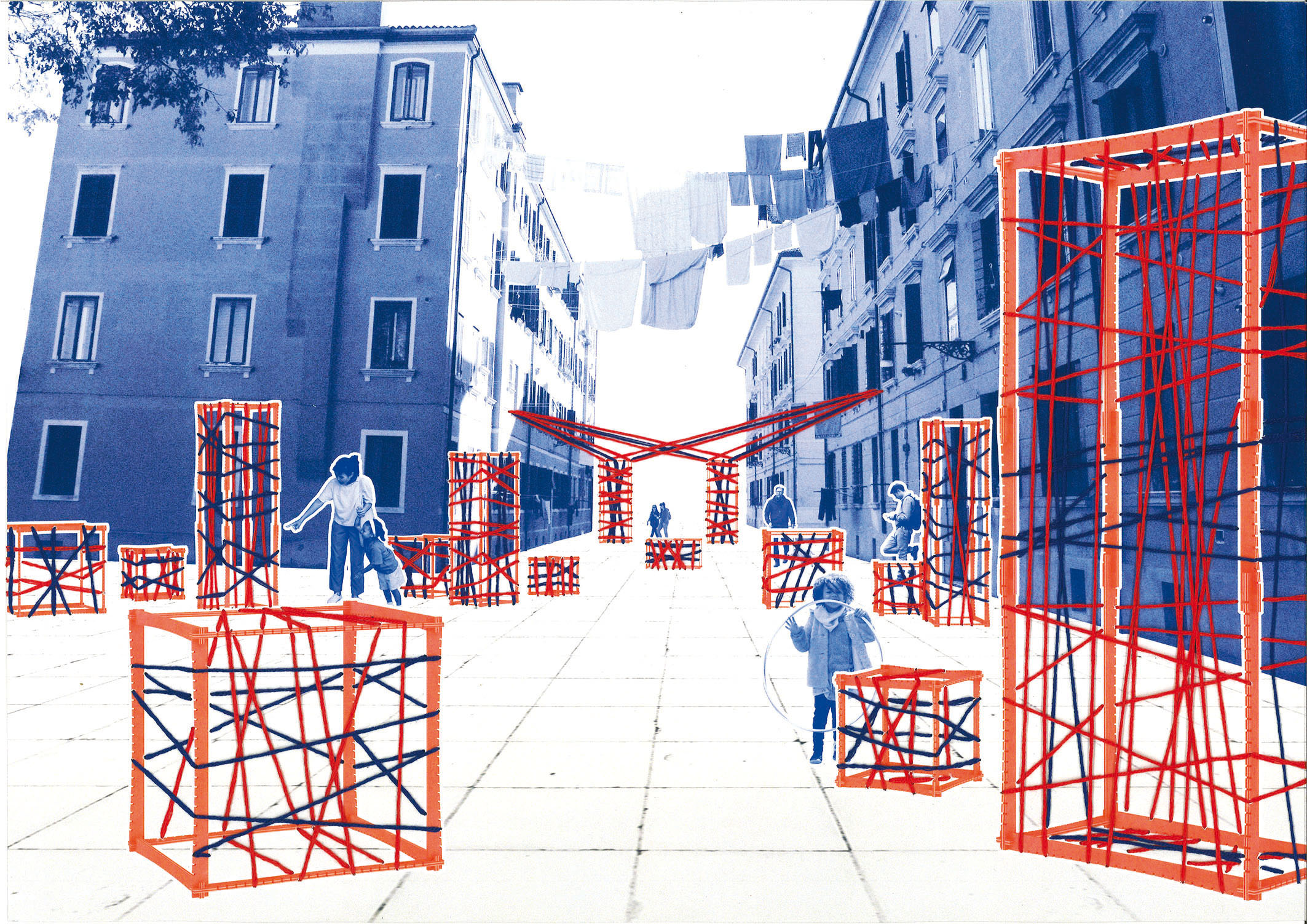
Imagine a tall structure that uses mirrors on top to take your view away, reflecting the blue-marine water behind the wall of Santa Marta — the architectural construction which deprives the residents of the direct view of the Venice lagoon. Accompanied with the sound composition installation, Otre* is transporting users beyond the barrier. This is one of the projects by students of the Design department of IUAV University, aimed to create a new relationship for a better future of the residential Venetian district.
View of Santa Marta wall. Ph. Veronika Motulko for VDB.
Render of project "Oltre*" by Giulia Cassiani, Maddalena Martani, Elena Pagotto, Giulio Villano.

Ph. Umberto Ferro / Luca Pilot: laboratorio fotografico Iuav.
“Santa Marta: something that deserves” is the title of the Laboratory that for a whole semester engaged the IUAV Design students, coordinated by professors Raffaella Fagnoni and Paola Fortuna, with the collaboration of Damiano Fraccaro. Organized into 15 groups, the students developed a path through Santa Marta, following the approaches of Social Design, Design for Social Innovation and Design of Services, interacting with citizens and local actors to develop their design proposals and act as activators of change processes. The main task is to design not only things but relationships between things.

Ph. Damiano Fraccaro.


The residential area of Venice Santa Marta has a curious and unusual shape, distinct from the familiar landscape of the city. Created initially with more functional than decorative purpose, the assemblage of buildings is much diverse in appearance than in most other areas. The foundation of the district dates back to 1920, when the municipality of Venice was funded to build new houses mainly intended for the workers of the Venetian Cotton Mill.
Project "Ndemo". Design by Nicolò Formentini, Davide Prontera, Giorgia Pierobon, Andrea Semilia.
In 1928 the first construction of 14 buildings, which expanded in 1929 with 365 new apartments that were built under the guidance of Paolo Bertanza, whose aim was to maintain Venetian architectural imprint and create porches with small squares to enliven the rigidity of the building cubes.


Ph. Veronika Motulko for VDB.
Furthermore, this area with a wonderful panorama and such a different conformation compared to the city took a new connotation nowadays. Transformed into a center for study and sharing, it is built up by the university campuses and dormitories nearby the residential buildings.


Paola Fortuna, the designer who is co-curating the project, lived in the Santa Marta district for 10 years during her studies and is very attached to the inhabitants and area itself. She says: «Product and communication design can offer a concrete contribution to the dynamics of social cohesion. With this objective, (…) we have worked to give form and substance to the multiple aspects linked to the idea of recognition and sharing, to translate and decline them in the ways of concrete action (…)».
Project "Together" by Francesco Argentino, Francesco Carraretto, Francesca Ciulla, Anna Giambellini;
Project "Oltre*" by Giulia Cassiani, Maddalena Martani, Elena Pagotto, Giulio Villano;
Project "Spiaja" by Sara Ceccato, Marta Finotti, Paul Veloz.
Ph. Umberto Ferro / Luca Pilot: laboratorio fotografico Iuav.
Building trust with the locals became a starting point for the students as the success required reciprocity in intentions and comprehensions. Step by step, residents shared their stories and memories, together with the art they have.

Among the numerous projects proposed are the exhibition of local artists, a revival of the antic traditional festival of light, and the atmosphere of the beach that was a long time ago an important place of encounter and celebration — all united by the idea of preserving the identity of Santa Marta and bringing the community together. For example, Bisegàr is a series of paths that cross Santa Marta, enacted in a treasure hunt with which you can discover the curiosities and the history of this neighborhood. The design intent was to tell the territory, through the stories and events that the inhabitants told the authors. The paths are guided by three thematic booklets: historical, students, and projects supported by interactive signboards.


From the top:
Project "I lumi di Santa Marta" by Francesca Ceccacci, Filippo Ferrarini, Gaia Graziotto, Eleonora Petrassi;
Project "Bisegàr" by Gianmarco Gallina, Gianmarco Poggiana, Federica Trenti;
Project "De Novo" by Elisa Maria Di Carlo, Giulia Francesca Patellaro, Francesca Pilon, Sveva Stanghellini.

In this gallery:
Project "Dog Tour" by Bruno Calza, Giovanni Capra, Mattia Marcon, Ayele Padovan;
Project "Ciacole in cusina" by Anna Faoro, Cecilia Marcolini, Alice Marescotti, Emma Scala;
Project "Tracce" by Alice Carraro, Leonardo Finotto, Luna Sala, Asia Zurlo;
Project "Santa Marta Film Festival" by Anna De Lazzari, Daniela Drumea,Matthew Mahoney, Efren Trevisan;
Project "Santa Marta si ricuce" by Sara Cavallini, Carmen Digiorgio, Margherita Gallon, Ilenia Romana.
With attention to the expansion of the green areas project, Ca’mpo created the system of the raised gardens that can be used as common spaces. Ca’mpo is referring to the typical word «campo» that is used in Venetian to name the squares. Due to the lack of outdoor sittings, residents are bringing their own chairs to the streets. Integrating seats into gardens will also initiate sociality.

While Ca’mpo develops the topic of the area’s infrastructure, Martamarcà project spreads the idea of the barter market as a public place where the meeting between citizens leads to greater conviviality and incentives a circular economic model. The structures where the exchange will take place will be built together by the locals what creates an atmosphere of cooperation and participation among the community.

The process of research and development was done with great participation of the residents and special contributions by Mara Rumiz, Marco Forieri, Tiziana Plebani, Michela Maguolo, Sabina Rizzardi, Vincenzo Casali and Emma Soletti, who made it possible to bring the initiative into life.
“Santa Marta: something that deserves” brought a breath of fresh air into the life of the area and helped not only to preserve but discover a new identity of it.
Read more about the projects at the dedicated page of IUAV University.









